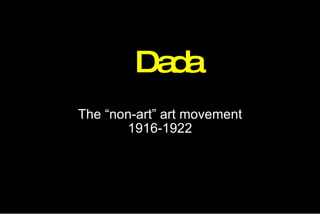
Dada
- 1. Dada The “non-art” art movement 1916-1922
- 2. What is Dada? is a cultural movement that began in Zürich, Switzerland, during World War I and peaked from 1916 to 1922. The movement primarily involved visual arts, literature, poetry, art manifestoes, art theory, theatre, and graphic design, and concentrated its anti-war politics through a rejection of the current standards in art through anti-art cultural works
- 3. Dada was not art; it was anti-art. For everything that art stood for, Dada was to represent the opposite. Where art was concerned with aesthetics, Dada ignored them. If art is to have at least an implicit or latent message, Dada strives to have no meaning--interpretation of Dada is dependent entirely on the viewer. If art is to appeal to sensibilities, Dada offends. Perhaps it is then ironic that Dada is an influential movement in Modern art. Dada became a commentary on art and the world, thus becoming art itself.
- 4. Famous visual artists involved in the Dada art movement: Hans Arp Marcel Duchamp Francis Picabia Hugo Ball Max Ernst Raoul Hausmann Man Ray John Heartfield Marcel Janco Kurt Schwitters Sophie Taeuber-Arp
- 5. Hans Arp :French sculptor, painter, collagist, printmaker and poet of German birth. He developed a cosmopolitan outlook from an early age and as a mature artist maintained close contact with the avant-garde throughout Europe. He was a pioneer of abstract art and one of the founders of Dada in Zurich. Avant-guarde: represents a pushing of the boundaries of what is accepted as the norm or the status quo, primarily in the cultural realm. The Forest 1916 Shirt Front and Fork 1922
- 6. Marcel Duchamp Marcel Duchamp: was a French artist whose work is most often associated with the Dadais t and Surrealist movements. Duchamp's output influenced the development of post-World War I Western art. He advised modern art collectors, such as Peggy Guggenheim and other prominent figures, thereby helping to shape the tastes of Western art during this period. A playful man, Duchamp challenged conventional thought about artistic processes and art marketing, not so much by writing, but through subversive actions such as dubbing a urinal "art" and naming it Fountain. He produced relatively few artworks, while moving quickly through the avant-garde circles of his time.
- 7. Marcel Duchamp Cont. Fountain, 1916 Bicycle Wheel, 1913
- 9. Man Ray: was an American artist who spent most of his career in Paris, France. Perhaps best described simply as a modernist, he was a significant contributor to both the Dada and Surrealist movements, although his ties to each were informal. Best known in the art world for his avant-garde photography, Man Ray produced major works in a variety of media and considered himself a painter above all. He was also a renowned fashion and portrait photographer. He is noted for his photograms, which he renamed "rayographs" after himself
- 10. Man Ray Cont. Le Cadeau, 1921 Rayograph, 1921
- 11. Rrose Silany Sélavy emerged in 1921 in a series of photographs by Man Ray of Duchamp dressed as a woman. Through the 1920s Man Ray and Duchamp collaborated on more photos of Sélavy. Duchamp later used the name as the byline on written material and signed several creations with it. Duchamp used the name in the title of at least one sculpture, Why Not Sneeze, Rose Sélavy? .
- 12. Duchamp made the piece as a birdcage containing a thermometer, a piece of cuttlebone and 151 marble cubes. He crafted the cubes to look like sugar cubes. Only when lifting the cage does it become clear that it is much heavier than it would be if the cubes were made of sugar. About the sculpture, Duchamp said: It is a Readymade in which the sugar is changed to marble. It is sort of a mythologica l effect . Ready Mades or Found Art: describes art created from the undisguised, but often modified, use of objects that are not normally considered art, often because they already have a non-art function.